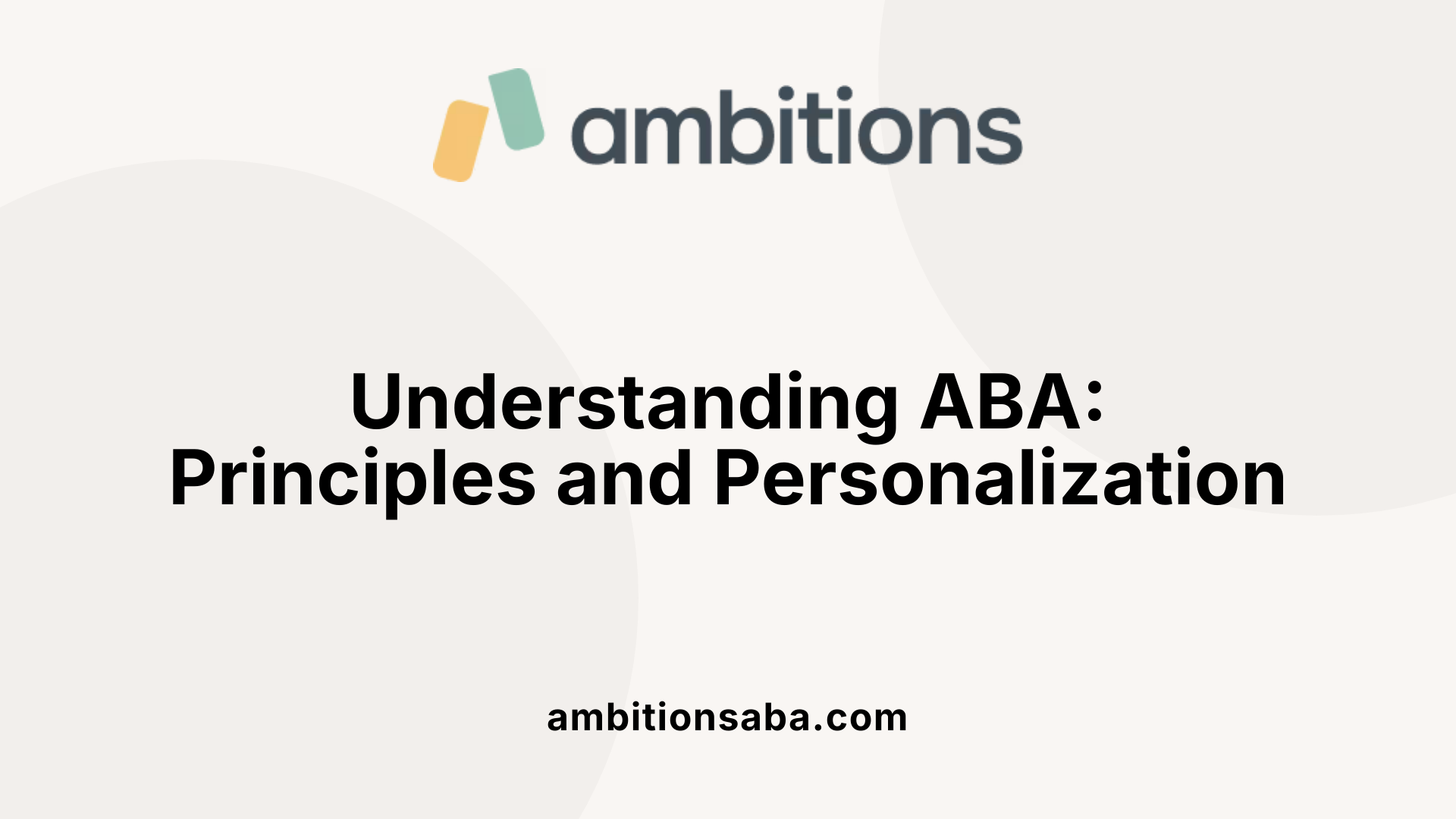Fostering Family Connections Through Sibling Involvement in ABA
Understanding the connection between play and ABA therapy
Applied Behavior Analysis (ABA) therapy is recognized as a highly effective, evidence-based approach to helping individuals with autism spectrum disorder (ASD) improve a range of skills, from communication to social interaction and daily living. A dynamic and individualized treatment, ABA's success is amplified through the integration of play-based strategies. This article explores the crucial role play has in ABA therapy, enhancing engagement, motivation, and learning while promoting vital developmental progress in children with autism.
What is Applied Behavior Analysis (ABA) therapy?

Definition and principles of ABA therapy
Applied Behavior Analysis (ABA) therapy is a scientific treatment focused on understanding how behavior works and how it can be influenced by the environment. This approach studies the relationship between behaviors and their surroundings, applying systematic methods to improve behaviors by encouraging positive ones and reducing negative or hindering behaviors.
Target populations and behavioral focus
ABA primarily supports individuals with autism spectrum disorder (ASD), along with others facing developmental or behavioral challenges. The therapy aims to enhance skills such as communication, social interactions, attention, academic ability, and daily living tasks, all essential for functioning effectively in everyday life.
Use of positive reinforcement and ABC model
A central technique in ABA is positive reinforcement, which involves rewarding desired behaviors to encourage their repetition. These rewards are tailored to each individual’s preferences to maximize motivation. ABA also uses the ABC model—antecedent, behavior, consequence—to analyze what triggers a behavior and its outcomes, allowing targeted modifications to promote beneficial behaviors.
Individualized program development and data-driven adjustments
ABA therapy is highly individualized. Programs are crafted based on detailed assessments of each person’s unique abilities, needs, and family input. Ongoing data collection and regular progress reviews by certified professionals ensure that goals are met and strategies adjusted to optimize outcomes.
Role of trained professionals and caregivers
ABA services are delivered by trained experts including Board Certified Behavior Analysts (BCBAs) and Registered Behavior Technicians (RBTs). They collaborate closely with families and educators to provide consistent, evidence-based interventions that fit into home, school, or community settings.
Together, these components make ABA a tailored, evidence-supported approach designed to produce meaningful improvements in skills and behaviors for individuals with autism and related conditions.
How ABA therapy supports individuals with autism

Behavioral improvements through positive reinforcement
ABA therapy uses positive reinforcement to encourage beneficial behaviors by rewarding individuals immediately after the desired action. These rewards are tailored to each person, making the learning process motivating and effective. By analyzing what happens before and after behaviors (using the ABC model: antecedent, behavior, consequence), ABA systematically reduces harmful or hindering behaviors.
Enhancement of communication, social, academic, and self-care skills
ABA works on multiple goal areas including communication, social skills, academic abilities, and self-care tasks like dressing or toileting. The therapy often begins at home and adapts to different settings such as school or community environments. Play-based techniques and group activities foster social interaction, cooperation, and language development, supporting children to build friendships and express their emotions.
Use of individualized assessment and intervention plans
Each ABA program is designed from detailed assessments considering individual strengths, needs, and family preferences. Certified behavior analysts regularly monitor progress through data collection and adjust plans to maintain optimal outcomes. Techniques may include discrete trial training, natural environment teaching, and pivotal response training, ensuring flexibility for each learner.
Evidence supporting meaningful developmental progress
Research identifies ABA as an evidence-based best practice treatment for autism, endorsed by major health organizations like the U.S. Surgeon General and American Psychological Association. Intensive, long-term ABA therapy (25-40 hours weekly for 1-3 years) has been shown to improve intellectual functioning, language, adaptive behavior, and social skills. While many studies report positive results, continued research with larger samples and long-term quality-of-life measures is recommended.
Broader benefits including independence and emotional regulation
Beyond skill acquisition, ABA therapy helps individuals with autism develop essential life skills and emotional regulation, preparing them to confidently handle real-world social situations. Children learn constructive ways to express feelings, improve attention and memory, and gain independence required for adulthood. Ultimately, ABA provides a structured path for individuals with autism to navigate their environments with greater competence and confidence.
The role of play in enhancing ABA therapy

How is play used to engage and motivate children in ABA therapy?
Play is a vital tool in ABA therapy, making learning fun and naturally motivating for children with autism. By incorporating enjoyable activities, children are more likely to participate actively, remain engaged, and reduce resistance to therapy. This increased motivation helps reinforce positive behaviors and skills.
How do play activities promote communication?
ABA therapy uses interactive play activities like storytelling and role-playing to encourage communication development. These activities allow children to practice using language in context, helping them to express ideas, understand others, and build vocabulary in a meaningful way.
How does play foster social skills through group games?
Group games are particularly effective in promoting social abilities such as sharing, turn-taking, and cooperation. Playing with peers creates natural opportunities for children to learn social cues, negotiate, and engage in reciprocal interactions essential for everyday social functioning.
What types of play are used in ABA therapy?
ABA therapy employs various forms of play, including:
- Structured Play: Planned activities with specific goals.
- Functional Play: Using objects purposefully, like pretend cooking.
- Social Play: Engaging with others for shared enjoyment.
- Guided Free Play: Allowing children to explore while clinicians provide subtle guidance. Each type targets different developmental skills to support holistic growth.
Why is play considered a naturalistic and enjoyable learning context?
Play creates an environment where learning happens in settings familiar or enjoyable to the child, such as home or school. This naturalistic approach helps generalize skills to real-life situations and maintains a positive, stress-free atmosphere conducive to learning.
Key ABA techniques and their integration with play

What methods and techniques are commonly used in ABA therapy?
ABA therapy employs several structured methods to teach new skills and reduce challenging behaviors. Discrete Trial Training (DTT) is a widely used technique that involves breaking down skills into small, manageable steps and teaching them one at a time in structured sessions. Prompting and fading are also used to support learning; therapists provide cues or help initially and gradually reduce assistance to promote independence.
Positive reinforcement is central in ABA, where desired behaviors are rewarded to increase their frequency. This can include praise, tokens, or preferred activities tailored to the individual, encouraging repeat engagement.
Video modeling and social scripts offer visual aids that help children learn social and communication skills by watching modeled behaviors and practicing scripted interactions. Redirection helps guide children from problem behaviors to appropriate alternatives.
How are these techniques integrated within play-based contexts?
Play is a valuable context in ABA therapy for making learning fun and engaging. Positive reinforcement happens naturally during play activities, as children receive immediate rewards like preferred toys or social praise, which increases motivation.
DTT components can be embedded in structured play, where skills like taking turns or following instructions are taught during games. Prompting and fading occur through guided play, allowing children to practice new abilities with diminishing help.
Natural Environment Training (NET), another ABA method, uses play and everyday activities within the child’s natural settings—such as home or school—to teach communication and social skills authentically. Play scenarios allow children to generalize skills they learn in therapy sessions.
Video modeling also fits well with play by showing children how to engage in social interactions or play sequences, which they then imitate and practice.
Together, these techniques create a dynamic learning experience where play supports skill acquisition, behavioral improvements, and social development in a motivating and enjoyable way.
Who provides ABA therapy and their qualifications
Professionals Involved in ABA Therapy
ABA therapy is delivered by skilled professionals including Board Certified Behavior Analysts (BCBAs), licensed behavior analysts, and registered behavior technicians (RBTs). BCBAs and licensed analysts typically oversee the development and implementation of therapy plans, while RBTs work directly with clients under their supervision.
Educational and Certification Requirements
To become a BCBA, individuals usually obtain a bachelor's degree in psychology or a related field, followed by a master’s degree focusing on Applied Behavior Analysis or a similar discipline. They must complete supervised fieldwork and pass a rigorous examination administered by the Behavior Analyst Certification Board (BACB).
Supervised Fieldwork and Ongoing Education
Certification requires substantial supervised practice hours where candidates apply ABA techniques in real-world settings. After certification, practitioners maintain licensure through continuing education, ensuring they stay current with advances in behavioral science and autism intervention strategies.
Collaboration with Families and Educators
ABA professionals actively engage with families and educators to tailor individualized treatment plans. They consider family preferences and educational goals to create practical, meaningful interventions for children with autism.
Role in Assessment, Implementation, and Progress Monitoring
Qualified ABA providers conduct detailed behavioral assessments and use data collection to monitor progress. Adjustments to therapy are made based on these evaluations to optimize outcomes, ensuring therapy remains effective and individualized over time.
Evidence supporting effectiveness of ABA therapy
What evidence supports the effectiveness of ABA therapy for autism?
Extensive research strongly supports ABA therapy as an effective treatment for individuals with autism spectrum disorder (ASD). Meta-analyses and randomized controlled trials have demonstrated that ABA significantly improves a range of developmental areas, including intellectual functioning and expressive language. For example, studies report large effect sizes for intellectual functioning (g=0.740) and expressive language (g=0.742), reflecting meaningful gains from therapy.
Standardized assessments like the Kindergarten Inventory of Social/Emotional Tendencies (KIST) confirm improvements in social, communicative, and adaptive behaviors among children receiving ABA. These outcomes boost emotional regulation, independence, and everyday functioning, especially when therapy begins early and is intensive, typically involving 25 to 40 hours per week over one to three years.
Early and intensive intervention models—such as Early Intensive Behavioral Intervention (EIBI) and the Early Start Denver Model (ESDM)—are particularly impactful. They use naturalistic and play-based techniques to make learning engaging and target crucial skills generalizable to real-life contexts.
While the overall evidence is positive, many ABA studies have limitations: small sample sizes, lack of control groups, and reliance on single-case experimental designs. This highlights the need for larger, rigorous, prospective studies comparing ABA to other therapies and assessing broad outcomes like quality of life.
In summary, ABA therapy remains the best-supported treatment for ASD, effectively enhancing intellectual, language, social, and adaptive functioning. Continued research is essential to refine approaches and evaluate long-term benefits comprehensively.
Challenges and criticisms of ABA therapy
What are the key challenges or criticisms associated with ABA therapy?
Applied Behavior Analysis (ABA) therapy, while recognized as an effective treatment for autism, faces several critiques. One primary concern is that some ABA programs can be overly rigid and repetitive, focusing heavily on compliance rather than accommodating the individual emotional needs of autistic children.
Historically, ABA included aversive techniques, such as punishment and even electric shocks, which have been discredited and replaced by positive reinforcement and more naturalistic methods. Despite these changes, some critics worry that ABA still attempts to suppress natural autistic behaviors like stimming, which may serve important self-regulation, potentially causing emotional distress or trauma.
The intensity of ABA therapy—often involving up to 40 hours per week—can contribute to caregiver burnout. Additionally, children may resist certain interventions, and skills learned in therapy sometimes fail to generalize well across different environments.
Modern ABA emphasizes individualized plans, compassionate approaches, and adapting techniques to each person's strengths and preferences. Nevertheless, ongoing debates highlight the importance of ethical, person-centered practices and continuous dialogue to ensure that therapy supports not only skill development but also the emotional well-being and identity of autistic individuals.
Future directions and the evolving role of play in ABA
Need for larger, rigorous studies on ABA outcomes including quality of life
Although ABA therapy is widely recognized as an effective treatment for autism, many existing studies feature small sample sizes and lack control groups. Future research calls for larger-scale, prospective studies that compare ABA with other interventions and deeply examine long-term outcomes such as quality of life. Measuring these factors will provide a clearer understanding of ABA's broader impact on individuals' daily functioning and wellbeing.
Integration of play-based models like naturalistic developmental behavioral interventions
Play is emerging as a central component in ABA, especially through approaches like naturalistic developmental behavioral interventions that incorporate play to boost motivation and learning. These models use structured and free play to foster communication, social skills, and engagement, making therapy more enjoyable and meaningful for children. Continued innovation will likely expand these play-based methods within ABA frameworks.
Expanding therapy settings for flexibility
The future of ABA includes greater flexibility in delivery settings, extending therapy beyond clinics to homes, schools, and community venues. This expansion enables individualized programming that fits each child’s lifestyle and surroundings, promoting generalization of skills and enhancing accessibility.
Emphasis on child motivation, engagement, and empowerment
New directions emphasize honoring each child’s interests and strengths to motivate participation in therapy. Play activities encourage engagement and empower children as active learners, ultimately fostering positive behavior and skill acquisition through enjoyable experiences.
Balancing evidence-based practice with respect for individuality and emotional health
While ABA remains evidence-based, future practice increasingly incorporates emotional regulation and respects individual differences. Therapists aim to balance structured learning with nurturing emotional wellbeing, promoting both effective behavior change and supportive, empathetic care.
| Focus Area | Future Direction | Impact on ABA Practice |
|---|---|---|
| Research | Larger, controlled studies emphasizing long-term and QoL outcomes | Stronger evidence base for policy and practice decisions |
| Play Integration | Broader use of play-based naturalistic interventions | Increased child engagement and improved social skills |
| Therapy Settings | Expansion to homes, schools, communities | Tailored, accessible therapy supporting skill generalization |
| Child Motivation and Empowerment | Individualized, interest-driven sessions | Enhanced participation, positive behavior reinforcement |
| Emotional and Individual Needs | Incorporating emotional health with behavior goals | Holistic development balancing efficacy and empathy |
Key takeaways on play-based ABA therapy
Play-based ABA therapy represents a critical evolution in the field of Applied Behavior Analysis, offering a natural, motivating, and enjoyable context for children with autism to acquire essential skills. By blending scientifically rigorous ABA methods with diverse play strategies—from structured to social and guided free play—therapists enhance engagement, communication, and social interactions, all crucial for real-world success. While ABA remains the gold standard for autism intervention, ongoing research and ethical awareness ensure its continued refinement. Ultimately, play-based ABA therapy serves as a bridge between evidence-based science and the joyful, meaningful experiences that foster lifelong learning and development.
References
- Applied Behavior Analysis (ABA)
- The Role of Play in ABA Therapy: Making Therapy Fun
- Applied Behavior Analysis in Children and Youth with ...
- 6 Benefits of ABA Therapy for Children with Autism
- Applied Behavior Analysis (ABA)
- The Top 10 Reasons Children With Autism Deserve ABA
- Applied Behavior Analysis (ABA)
- 6 Benefits of ABA Therapy for Children with Autism

